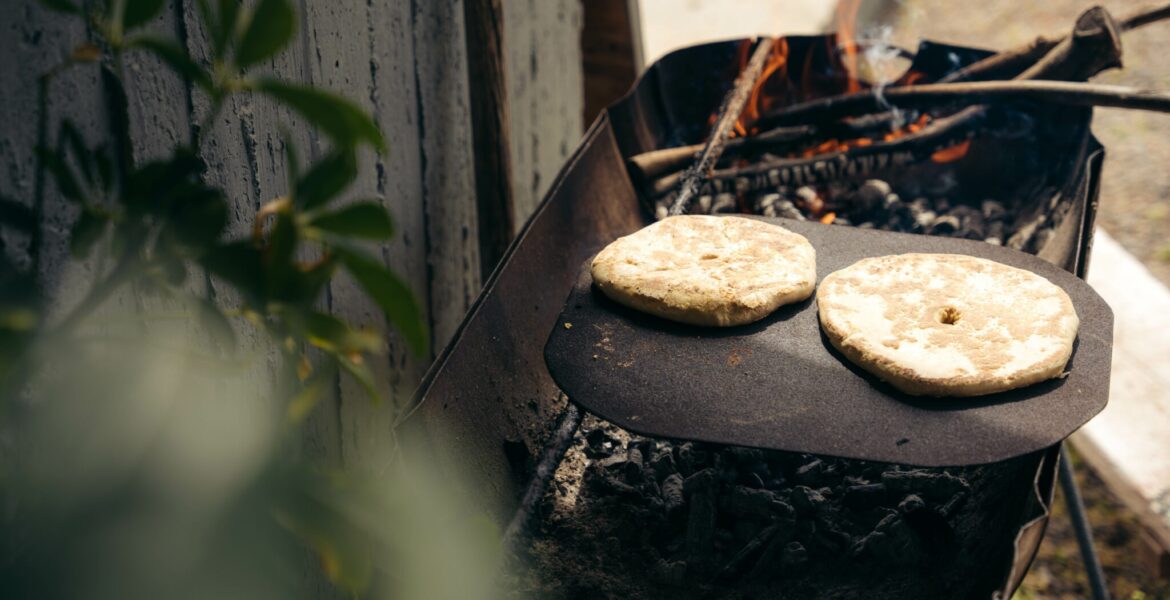Traditional plakopitas from the hands of women in Korakovouni, Arcadia.
We were told, "It's up the road as soon as you enter Korakovuni." Indeed, we found the two-story house with a yard. We barely arrived, and Mrs. Thomais came out to welcome us.
We had come here to try the famous plakopitas and, of course, to learn how they are made—a dish that is offered in these coastal villages of Kynouria and especially in Korakovouni.

Walking through the yard, I notice on the left a large flower bed of planted, now ready, green lettuces, as well as pea pods, climbing the wire fence. Mrs. Thomais has already collected some and has them on the table.
“I will clean and cook these in the next few days. I make them with spring onion, parsley, potatoes, and fresh tomato. I also put some in the fridge for later. These have no antibiotics or fertilisers," she said.
Pancakes on the iron plate
We will also meet Angeliki and Maria in the courtyard. Irene is the daughter of Thomais and arranges some technical issues. We will also see her later since she will show us around the village.
"They are called plakopitas because we make them on this iron or marble plate. It is the simplest and easiest bread, which we especially made in the past to take with us to the fields. It's very economical, it's very quick to make, and it can -what we say-sustain you!" Mrs. Thomais tell sus.

Put half a kilo of yellow and half white flour in a bowl. Add one tablespoon of baking soda, a little salt and cold water. After it has risen, divide the dough into small balls and roll them out with a rolling pin. The dough should not be too thin. It should be about half a centimetre thick.
After you place the iron plate on the fire and it heats up, you put the dough on it and create a small hole in the middle of it. The fire under the plate should not be too strong because the outside of the plakopita will burn, and the inside will not be cooked.


An ideal side dish for skordalia
The plakopitas are prepared one after the other. It is nice to try them warm, but they remain a bread worth tasting even after they cool.
"Usually, we have them in the fields with white cheese and olives. But there are other things that go well with pies. It is very common to make them with cod and skordalia," she said.

Yard talks
We stayed a long time. We saw the ease with which this traditional dish is made. We tried the plakopita with white goat's milk cheese, made by Mrs. Thomais herself, but also with olives.
We talked about the past. She told us about the work in the fields when they left all day to do the chores in the olive groves.

"Now I'm doing everything I can. The years have changed. I work in the garden here, and sometimes I also go to the olive groves," she tells me while I taste a bowl of peas.
I opened it to taste it; it was so fresh and raw. It is a special taste. This way, it maintains all its freshness.


The Greek cucina povera
We left Korakovouni and I think about the correspondence with the Italian cucina povera.
This cuisine that originates from the rural areas and comes back to the fore to bring the essence, the taste, the seasonality and the utilisation of the unique quality ingredients.
Such a philosophy can become capable of bringing balance to our daily diet.
Dimitri Stathopoulos is a columnist for Travel. Translated by Paul Antonopoulos.
READ MORE: Top 6 rooftop bars and courtyards in Athens.


